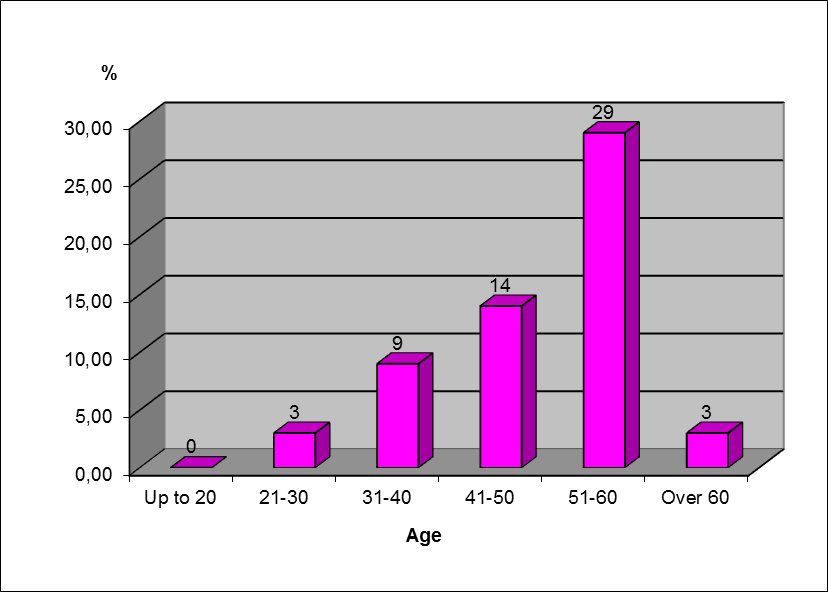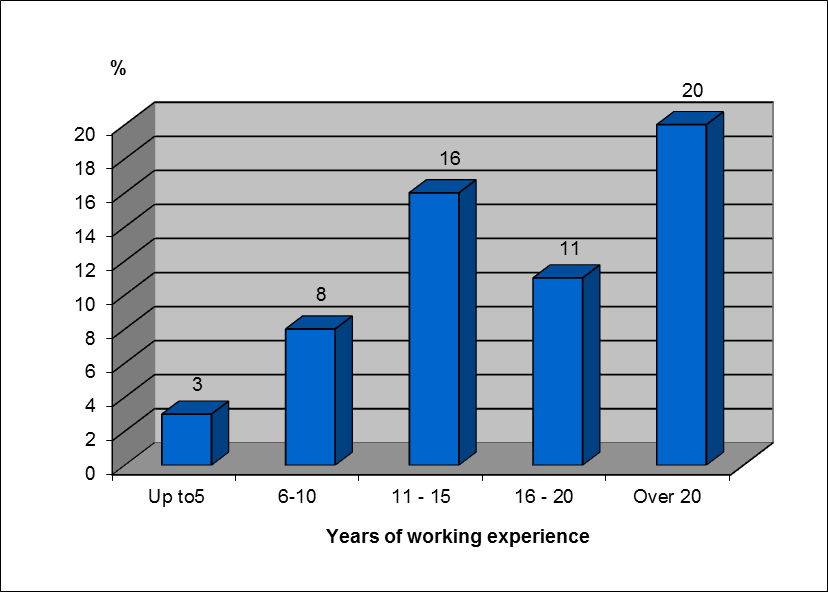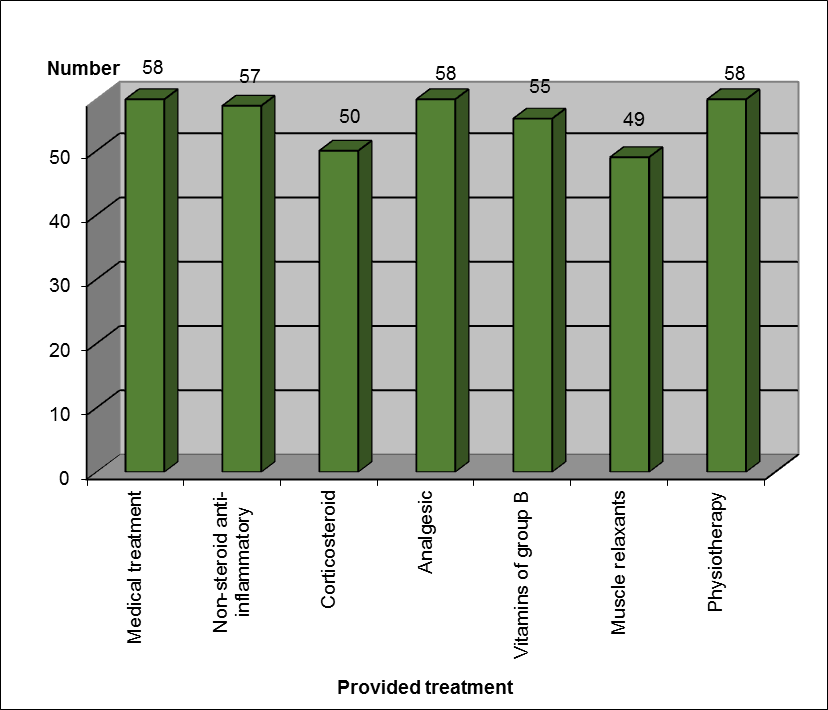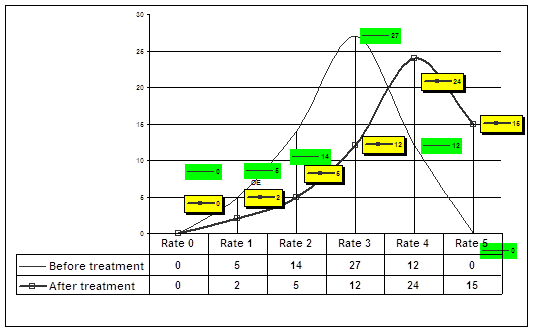BACKGROUND
Pain is a universal sign for threatening individual biological and psychical ill- being. It triggers defense mechanisms so as to restore balance in the body. [1 p. 130, 4 p. 59]
The main objective of this research is to optimize pain treatment with patients with occupation-conditioned diseases of the locomotor system (LMS) and the peripheral nervous system (PNS).
METHODS
The subject of this research are 58 people working in clothing industry, residents of the regions of Pleven, Lovetch, Veliko Turnovo and Gabrovo. The patients of this research were hospitalized in the Department of Occupational Diseases, UMHAT “Dr. Georgi Stranski”- Pleven, during the period 2014-2016.
Clinical, functional, laboratory and statistics methods are used for conducting the research. [5 p. 151, 6 p. 52]
RESULT
Total number of the people in the research – 58, Sex: women
Distribution according to age: from 23 to 62, average age 46,7 years (Figure 1).

Figure 1. Distribution according to age
Distribution according to years of working experience in the clothing industry (Figure 2).

Figure 2. Distribution according to years of working experience in the clothing industry
Distribution according to diseases (Figure 3).

Figure 3. Distribution according to diseases
It was provided a complex integrated medical treatment and physiotherapy (Figure 4).

Figure 4. Distribution according to provided treatment
The average period of hospitalization is 6 days.
Upon receiving and discharge of patients clinical examination and direct individual survey were conducted.
To assess the response to the pain of the applied treatment Visual Analogue Scale (VAS) and scale of Daily Living Activities (DLA) were used. [2 p. 20, 3 p. 302]
Intensity of pain by VAS is shown in Figure 5.

Figure 5. Intensity of pain by VAS upon receiving and discharging patients
Figure 6 shows the curve of the Wilcoxon for the averages of test DLA at the beginning and at the end of the treatment process.

Figure 6. Scale of DLA before and after the treatment
The good results of the test for DLA in the reference period, the formation of a peak and displacement on the curve of Wilcoxon to the right reflect significant better performance status of treated patients and improving the quality of their daily lives.
CONCLUSION
— Pain is a major and important event of work-related diseases of the LMS and the PNS.
— Integrated medication and physiotherapy successfully influence pain, improves functional status of patients and increase their quality of life.
References
- Birse T. M., Lander J. Prevalence of chronic pain. Can J Public Health, 1998 Mar-Apr; 89(2), pp. 129-131.
- Buckle P. Upper limb disorders and work: the importance of physical and psychosocial factors. J Psychosom Res., 1997 Jul; 43(1), pp. 17-25.
- Foley K. M. Acute and chronic cancer pain syndromes. In Oxford Textbook of Palliative Medicine, 3rd edn, eds. D. Doyle, G. Hanks, N.I. Cherny, and K. Calman. New York: Oxford University Press, 2004, pp. 298–316.
- Rashkov R., Sheitanov Y. Practical Guide in Rheumatology [in Bulgarian]. S. CIM, 2001, pp. 58-60.
- 5. Simeonova J., Velkova A., Tsvetkova S., Kostadinova P., Kamburova M., Georgieva S. Self-rated health, health behavior, perceived illness vulnerability, perceived controllability over health among ambulatory and hospitalized patients over 44 years of old [in Bulgarian]. Science & Technology, 2014, 4(1), pp. 250-255.
- Simeonova Y., Velkova A., Tsvetkova S., Kostadinova P. The meaning and dimensions of health self-assessment in individuals over the age of 18 [in Bulgarian]. Health policy and management, 2014, 14(2), pp. 49-55.[schema type=»book» name=»INFLUENCING PAIN RELIEF THROUGH COMPLEX INTEGRATED TREATMENT OF PATIENTS WITH OCCUPATIONAL DISEASES OF THE LOCOMOTOR SYSTEM AND THE PERIPHERAL NERVOUS SYSTEM» description=»Pain is an unpleasant sensory and emotional experience, associated with present or potential tissue damage. Chronic work related syndrome is typical of many injuries to bones, joints, muscles and peripheral nerves. The aim of the study is to optimize the treatment of pain in patients with work related diseases of the bones-joints and peripheral nervous system. The subject is 58 people hospitalized in the Department of Occupational Diseases, University Hospital – Pleven in 2014-2016. Clinical, laboratory, electrophysiological and imaging diagnostic methods are used. Conclusions are made and given recommendations for optimizing the treatment of pain in work related dis-eases.» author=»Stoilova Irena Yordanova, Krustanova Maya Stefanova» publisher=»БАСАРАНОВИЧ ЕКАТЕРИНА» pubdate=»2017-02-14″ edition=»ЕВРАЗИЙСКИЙ СОЮЗ УЧЕНЫХ_30.01.2017_1(34)» ebook=»yes» ]

